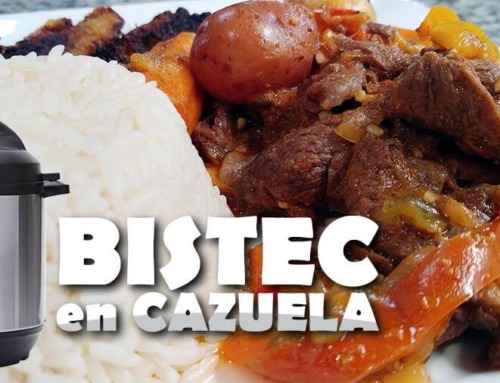Hello, and welcome back to the Cuban Redneck Kitchen, where today we will tackle an authentic Cuban recipe, the one, and only Quimbombo. Before we start, I want to thank everyone who has supported the growth of our Facebook group – Cuban Food Nation. We now have nearly one thousand members, and we are welcoming new members daily. While I am starting to limit my exposure to Facebook, being part of a private group like this where like-minded people share a common interest is a nice distraction in our lives. Now, If I could only get more people to participate, I think we can grow this group into a stellar community.
Today’s recipe, the Cuban Quimbombo, could be controversial, and that is because of some of the properties of this vegetable of West African origin possesses. The Quimbombó (pronounced keem-bohm-BO) can be a bit slimy (in Spanish, Ba-Ba). That is a property that some like and others don’t. I personally don’t care for it, but it seems that this is always a talking point when we are talking about Quimbombó, which in English is called Okra or Okro.
If you are from the Northeast or Northwest, this may be something you may have never seen or heard. Outside of Louisiana and South Florida is not something I have encountered in my travels, and that is a shame because this is a very nutritious vegetable. Several times more nutritious than corn, for example, and an excellent source of minerals, vitamins, antioxidants, and fiber. Unlike other vegetables that may yield only one fruit per plant, the Quimbombó produces a great harvest.
The Quimbombó, Okra, Okro, Abelmoschus esculentus, Ladies’ Fingers, or Ochro came to the Americas during the slave trade. Different versions of the original okra stew recipe can be found in many parts of the world, and today it is still a prevalent dish in places like Ghana. Where some claim it originated. In New Orleans is a vital part of any Gumbo. Some of the most traditional Louisiana Okra dishes include Chicken-and-Okra Gumbo, Seafood and Okra Gumbo, and Shrimp and Okra Gumbo. The Cuban version of the Okra Stew, known as Quimbombó, is unique because it always incorporates plantains. I believe the original recipe calls for a ball made from a mixture of ripe and green plantain, a kind of FuFu. As long as the plantain is present, I don’t care what shape they are in, slices, balls, or dumplings.
Quimbombo Ingredients:
- 2 lbs. Of Quimbombo / Okra
- 1 tsp. Salt, Black Pepper, Cumin, Oregano, Onion Powder
- ½ an Onion
- ½ a Bell Pepper
- 2-3 Cloves of Garlic
- ¼ of Lemon Juice
- 2-3 Tbsp. of Olive Oil
- ¼ Cup Cooking Dry Wine
- 1 – Half Ripe Plantain
- 1 – Cup of Tomato or Pasta Sauce
- 2 – Cups of Beef Broth
- 2 lbs. of Pork (Country Style Ribs)
Quimbombo con Carne de Puerco y Platano / Okra Stew with Pork and Plantain
Making a traditional Cuban Quimbombo con Carne de Puerco y Platano or Cuban style Okra Stew with Pork and Plantain is very easy. In this recipe, I will be using what some may consider restaurant methods instead of more traditional Cuban household methods. One of my key reasons for this is to cut the slime or baba as much as possible. Something else a bit different is that I will be using Country Style boonless ribs for this Quimbombo Cubano. Country Style boonless ribs are a cut of pork that is sometimes criticized for being a bit tuff but don’t worry, we’ll take of that!
The first thing we are going to do is rinse our pork with a mixture of water and vinegar. Simply add 2-3 tablespoons of any vinegar to about 2-3 quarts of water. Rinse the pork, and then pad it dry with paper towels. Then make a 50/50 mix of salt and baking soda, mix it well and sprinkle your pork. Let it rest in the fridge for about 2 hours, and you are good to go. Some may say it is unnecessary, but I like to rinse the pork once again and then reseason it lightly with salt and pepper.
Once you have the pork ready, we’ll start by bringing 2-3 tablespoons of olive oil to temp in a large saucepan. Once the oil is hot, bring in your okra and sauté it for 3-4 minutes, or until it starts to show some brown ends. At this time, add ¼ cup of lemon juice and continue to cook for another minute or so while stirring it. As the lemon juice evaporates, put the okra back in the container you had it in.
We are now going to sear the pork, and you may or may not need a little more oil. We are looking to do here just the sear and give the pork a little bit of color and not looking to cook it through at this time. As the pork starts to brown, we can add the onion and bell peppers. Continue to cook under medium heat for about 2-3 minutes, at which time we’ll add the garlic. Give that a minute or so while stirring it, and add ¼ cup of cooking dry wine to deglaze the pot. As the bottom of the pot starts to clean up, let’s add one cup of tomato or pasta sauce and two cups of beef stock. Crank the heat to medium-high and bring to a boil.
Once our pot comes to a boil, add the dry spices, stir, and add the plantains. Give it another quick stir, put the lid on the saucepan, and cook over medium heat for 20 minutes. At the 20-minute mark, we are going to check our plantains for doneness. If you can drive a fork into them, go ahead and add the okra, put the lid back on, and cook over medium heat for an additional 10-minutes. At this time, let’s check both the okra and the plantains, and if both are to the tenderness of your liking, take it off the heat, and let it stand for bout 5 minutes before serving.
As all okra stews, Quimbombo con Carne de Puerco y Platano is a hearty meal, and more often than not, plain white rice is the perfect match. I prefer a side of Maduro’s (sweet ripe fried plantains), but some tostones or fried yuca is welcome as well!
Thank you for stopping by, and more importantly, thank you for watching. If you have a favorite recipe that I still to cover, please leave me a comment. I’ll see you next week with yet another Cuban recipe… or Caribbean, or American, not sure. We’ll see what I find on sale this weekend.





